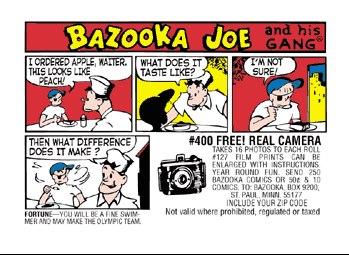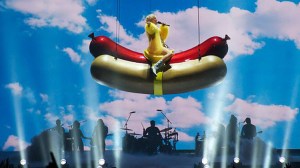
Here’s something I’ve been chewing over for a long time.
Sixty years ago Bazooka Joe—the iconic character created by a Long Islander—debuted in a little strip wrapped around pieces of Bazooka Bubble Gum. Last November, Bazooka Candy Brands—a division of Topps (the company behind so many sports and other trading cards)—announced that they would no longer include Bazooka Joe inserts with their bubblegum, citing decreasing sales.
Joe and the gang were, it seems, being put out to pasture, where they might as well be blowing smoke, perhaps, as bubbles.
How ironic that Abrams ComicArts has just come out with a book, “Bazooka Joe and His Gang,” which features an anthology of 100 strips including the complete first series as well as essays about the kid in the black eye-patch with his baseball cap on sideways.
I can remember my shock, growing up on Long Island, when Bazooka gum jumped from a penny to two. The whole thing about bubble gum was that it cost you almost nothing. And, in all seriousness, as a little kid, being able to walk into a candy store and make your own purchase (with another 12 to 20 cents for a comic book, of course!) might even give you your first taste of fiscal empowerment.
This was still back in the day when candy stores seemed to be everywhere. You’d walk in, and often there’d be a lunch counter as well. My next door neighbor, Sam Picker, used to walk up two blocks almost every night to Dutch Broadway in Valley Stream to have his ice cream soda for desert!
I can remember it was a big deal when Bazooka introduced new flavors: grape and cherry, as I recall.
But that might have been after 1973, when it felt like almost all the candy stores on Long Island mysteriously transformed into “stationery stores.” A slice of Americana disappeared forever.
I had always loved the Bazooka Joe characters. Some years ago I was a little horrified when I unwrapped a piece and the cartoons had changed. Gone were the familiar designs, replaced by some odd nouveau version of the gang.
Why, I thought, if Bazooka had finally gone to the extent of creating some fun new adventures, had they not hired an artist who could draw in the classic style? Bazooka Joe may not have been Norman Rockwell, but I thought his place in pop culture might have been pretty well secured.
Some time later I was embarrassed when I was airing my criticism of the new Bazooka style in a phone chat with Howard Cruse, the terrific comics artist/writer, only to discover that he had been the recidivist perpetrator!
Among his many aptitudes, Cruse can replicate other illustrators, so I asked him why he hadn’t created the new strips in the classic fashion.
He told me he was charged by Topps with creating “a teenaged, and therefore, by definition, heretically altered versions” of the Bazooka crowd.
“I doubt that I could have mimicked the drawing style of the ones you grew up with if that had been what Topps wanted,” Cruse said. “It’s really hard to pull off cartooning jujitsu with anything that has to be drawn at that ridiculously small size! In other words, at that scale I was barely able to render my own style, much less anyone else’s!”
Topps itself is something of an American success story, the 1937 brainchild of the brothers Shorin: Abram, Ira, Phillip and Joseph. They launched Bazooka Bubblegum in 1947, and began experimenting with comic strip inserts, including the exploits of “Bazooka The Atom-Bubble Boy.””
But their first attempts evidently didn’t catch on.
“Bazooka Joe” was created by Woody Gelman, the head of Topps Product Development Department, and the artist he turned to was Wesley Morse.
Gelman, a long-time resident of Malverne, passed away in 1978.
“Woody was the nicest, most creative and gentlest man I ever met,” said Len Brown, a Brooklyn-born writer/editor, who retired from Topps. “I owe my career to Woody, who I met by chance when I was not quite fourteen years of age. And when I hit 18, I walked into 254-36th St. in Brooklyn, because of him, and maintained a desk at Topps for the next 40 years.
“He was the father to me that I had lost at the age of five,” Brown told me. “Do you get the idea that I have a real fondness for this man? I can still dream about him occasionally and I am always grateful….”
In 2007, Topps was purchased by Michael Eisner’s The Tornante Company and Madison Dearborn Partners, a private equity firm specializing in leveraged buyouts. Eisner, once the phenomenally successful head of Disney, announced in 2009 that he was going to try to turn Bazooka Joe into a movie franchise.
Why now would a company virtually jettison its branding trademark?
One cigarette/Lotto shop owner in Lynbrook I recently spoke with used to have that prototypical clear plastic bowl of Bazooka right on his counter near the cash register, and he would be glad to do so again, but he had simply forgotten about it. And no one from Topps or even a local distributor had reminded him about it for years.
So, there you go. Say it ain’t so, Bazooka Joe.
And if there are any among you who never pulled a T-shirt or a turtleneck over your nose and didn’t think of Joe and his gang, I’ll treat you to a Wetson’s burger, a Black Cow candy pop, and a whole month of Sundays.
 James H. Burns is a writer/actor living in Valley Stream who has made several contributions to Broadway and Off-Broadway productions. His writings have appeared in Gentleman’s Quarterly, Esquire, Twilight Zone and Heavy Metal, and more recently in Newsday, The Sporting News, CBS-NY.com, The Village Voice and The New York Times. More of his articles are available at http://thethunderchild.com/BurnsintheCity/index.html
James H. Burns is a writer/actor living in Valley Stream who has made several contributions to Broadway and Off-Broadway productions. His writings have appeared in Gentleman’s Quarterly, Esquire, Twilight Zone and Heavy Metal, and more recently in Newsday, The Sporting News, CBS-NY.com, The Village Voice and The New York Times. More of his articles are available at http://thethunderchild.com/BurnsintheCity/index.html


























